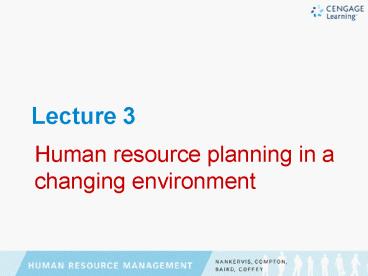Human resource planning in a changing environment PowerPoint PPT Presentation
1 / 29
Title: Human resource planning in a changing environment
1
Lecture 3
- Human resource planning in a changing environment
2
Introduction
- Human Resource Planning
- The bridge between HR strategies and HR
functions is the formulation of human resource
plans that incorporate the desired outcomes of HR
strategies, are responsive to continual changes
in dynamic national and global industry
environments, and can be implemented through
efficient and effective HR functions... - (Nankervis, Compton, Baird Coffey 2011, p.120)
3
Human Resource Planning
- Ensure organisational objectives are met through
effective utilisation of human resources - Considerate of changing circumstances within and
outside the organisation - Is an ongoing process, focused on the long-term
- Cognisant of contemporary changes in both
internal and external environments - A series of processes, with long-, medium- and
short-term contingency options - Based upon efficient, effective and user-friendly
HRIMS
4
Strategic alignment
5
Human resource planning (HRP)
- Sometimes called workforce planning
- translates the organisations objectives
- ensures that organisations have the right people
in the right place, with the right skills, at the
right time and at the right place - translates organisational plans into HR plans
that guide the long-term acquisition, use and
development of intellectual capital and knowledge
assets
6
Group discussion
- Strategic HRP
- Discuss the following statement Strategic HRP
is impossible given the dynamism and complexity
of the global economy and with the short-term
perspectives of most companies and governments.
7
HRP and strategicorganisational planning
- Determination of necessary labour requirements
(demand) - Prediction of likely sources (supply)
- Environmental scanning
- Evaluation of strengths and weaknesses
- Development of objectives and goals
- Formulation of suitable strategies
8
Approaches to SHRP
9
Effective integration of HR and strategic plans
- Depends on many factors including
- nature and stage of organisation
- organisational size
- history, culture and philosophy
- nature of business strategies
- location and level of the HR function
- values and skills of senior HR managers
10
Group discussion
- Environmental scanning
- Discuss the following statement
- Talent management and talent retention are the
only priorities for HR planners in todays
organisations.
11
A model of strategic human resource management
12
Group discussion
- Global financial crisis (GFC)
- Following the recent global financial crisis,
which HRM issues should HR professionals be
focusing on to ensure their organisations
sustainability?
13
The process of HRP
14
Labour demand forecasting
- Estimating in advance the number and type of
employees required - Complex or simple techniques can be used
- Dependent upon
- expertise of HR
- complexity of organisational structures
- market factors
- external environment
15
Group discussion
- Labour demand forecasting
- Consider the nature of the future fast food or
retail industries workforces. Is there likely to
be more or less employees, ore highly-skills or
less skills staff, and/or greater use of
technology to replace labour?
16
Labour supply analysis
- Determining if labour requirements are available
- when and where needed?
- internal or external sources?
- internal supply analysis
- skills inventory
17
Group discussion
- Labour supply analysis
- Consider the relative advantages and
disadvantages of global versus local labour
markets in relation to an organisation of your
choice.
18
Human resource information management systems
(HRIMS)
- Originally manual
- Increasingly complexity of legislation
- Payroll systems
- Development of flexible and comprehensive systems
- Increasingly computerised and information
technology focused - Strategic tool for HR planning and cost-effective
HRM
19
A model of strategic HRP using HRIMS
20
Benefits and features of HRIMS
- Improved planning and program development
- Faster information processing
- Improved response times
- Decreased administrative and HR costs
- Accuracy of information
- Enhanced communication at all levels
21
Types of HRIMS data
- Aggregated data on all aspects of the employment
relationship including - Administrative
- industrial awards, HR policies, salary, leave
- Operational
- personal and job histories, records on
recruitment and selection - Strategic reasons
- all the above plus wastage, staff positions,
labour market trends
22
The role of HR information in the HR strategic
planning process
23
Ownership, confidentiality and privacy of HRIMS
data
- Who has access?
- keys and codes
- Protection of data
- Ethical issues
- Outsourcing
- Data ownership
- Freedom of Information legislation versus Privacy
legislation
24
Successful HRIMS
- Accurate employee and job data
- Flexible and adaptable
- Clear link with and contribution to HR plans
- Modular and integrated
- Clear control of HR costs
25
External supply
- Considered when
- lack sufficient internal supply
- entry-level positions
- Influenced by many complex factors
- Other options?
26
The external environment
- Crucial success factors include
- recruiting and retaining skilled employees
- increasing customer satisfaction
- employing and developing leaders
- sustaining a competitive advantage
- managing risk
- managing change and corporate culture
- becoming an innovative organisation
27
Group discussion
- Human resource management information systems
(HRMIS) - Argue the cases for
- Maintaining an HRIMS wholly within the
organisation - Integrated HRIMS, including internal and external
service providers - An entirely outsourced HRIMS
28
Human resource planning
- Drawbacks
- Benefits
- Time-consuming
- Difficult/complex
- Costly
- Inadequate support
- Obstruction
- Better match between employee and organisational
objectives - Increased productivity and profitability
- Better integration
- Timely staffing and skill requirements
29
Summary
- Effective HRP
- Management commitment
- Importance placed on human resources
- Links between external and internal environments
and organisational strategies - Effective linkages between HRP and HRM
- Adequate staff, time and resources
- Effective HR information systems

